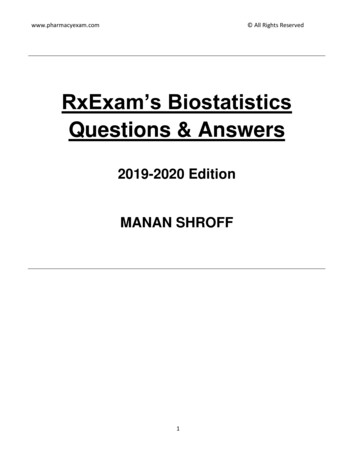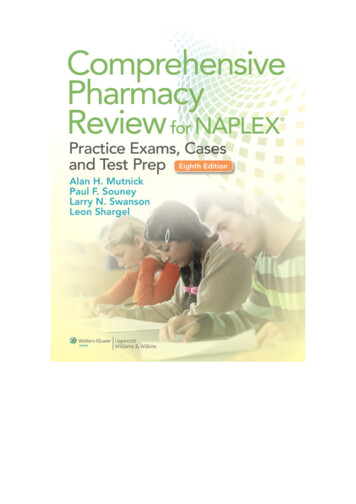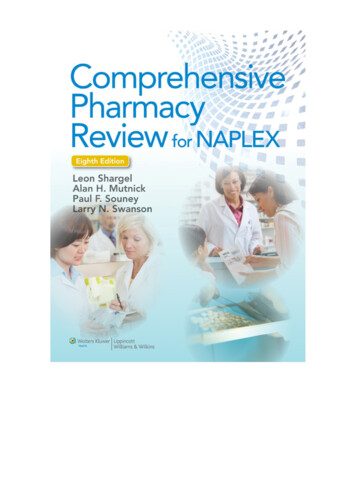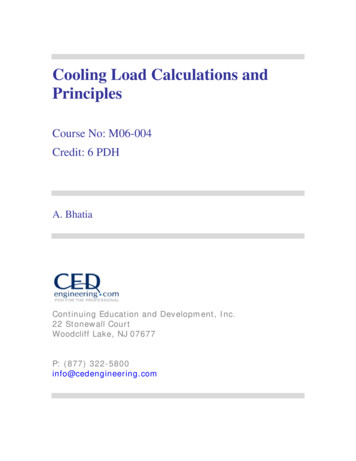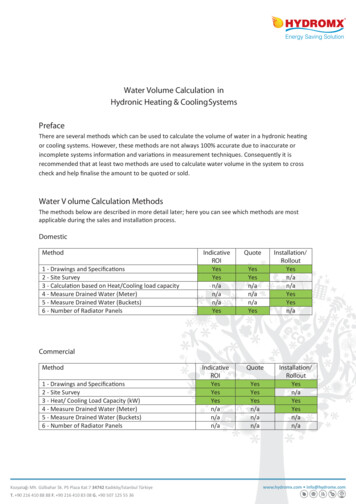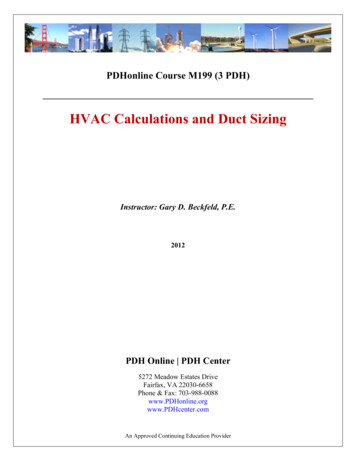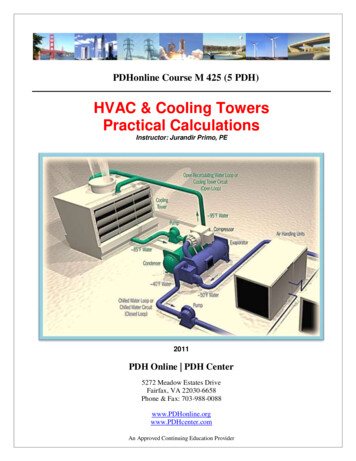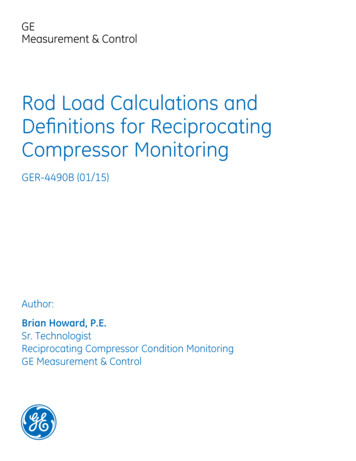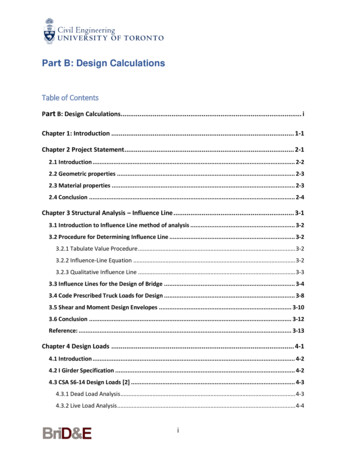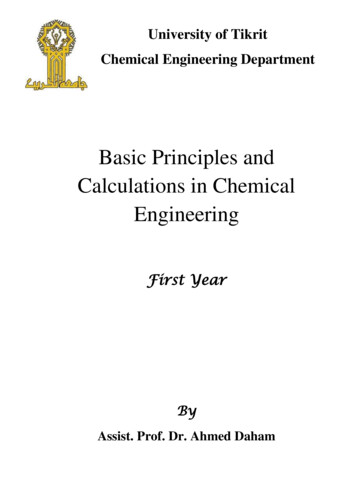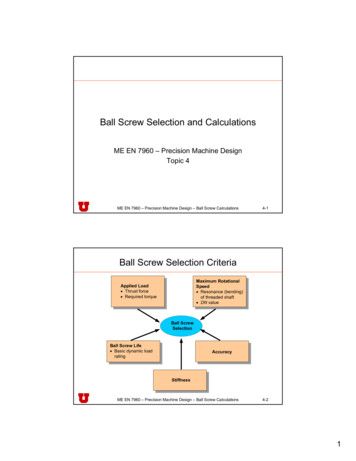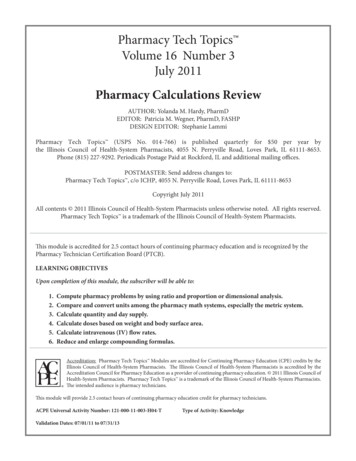
Transcription
Pharmacy Tech Topics Volume 16 Number 3July 2011Pharmacy Calculations ReviewAUTHOR: Yolanda M. Hardy, PharmDEDITOR: Patricia M. Wegner, PharmD, FASHPDESIGN EDITOR: Stephanie LammiPharmacy Tech Topics (USPS No. 014-766) is published quarterly for 50 per year bythe Illinois Council of Health-System Pharmacists, 4055 N. Perryville Road, Loves Park, IL 61111-8653.Phone (815) 227-9292. Periodicals Postage Paid at Rockford, IL and additional mailing offices.POSTMASTER: Send address changes to:Pharmacy Tech Topics , c/o ICHP, 4055 N. Perryville Road, Loves Park, IL 61111-8653Copyright July 2011All contents 2011 Illinois Council of Health-System Pharmacists unless otherwise noted. All rights reserved.Pharmacy Tech Topics is a trademark of the Illinois Council of Health-System Pharmacists.This module is accredited for 2.5 contact hours of continuing pharmacy education and is recognized by thePharmacy Technician Certification Board (PTCB).LEARNING OBJECTIVESUpon completion of this module, the subscriber will be able to:1.2.3.4.5.6.Compute pharmacy problems by using ratio and proportion or dimensional analysis.Compare and convert units among the pharmacy math systems, especially the metric system.Calculate quantity and day supply.Calculate doses based on weight and body surface area.Calculate intravenous (IV) flow rates.Reduce and enlarge compounding formulas.Accreditation: Pharmacy Tech Topics Modules are accredited for Continuing Pharmacy Education (CPE) credits by theIllinois Council of Health-System Pharmacists. The Illinois Council of Health-System Pharmacists is accredited by theAccreditation Council for Pharmacy Education as a provider of continuing pharmacy education. 2011 Illinois Council ofHealth-System Pharmacists. Pharmacy Tech Topics is a trademark of the Illinois Council of Health-System Pharmacists.The intended audience is pharmacy technicians.This module will provide 2.5 contact hours of continuing pharmacy education credit for pharmacy technicians.ACPE Universal Activity Number: 121-000-11-003-H04-TValidation Dates: 07/01/11 to 07/31/13Type of Activity: Knowledge
Pharmacy Calculations ReviewMEET THE AUTHORYolanda M. Hardy, PharmDAssistant Professor of Pharmacy PracticeChicago State University College of PharmacyChicago, ILDr. Yolanda M. Hardy is an Assistant Professor of Pharmacy Practice at Chicago State University College of Pharmacy.She is also an adjunct professor at South Suburban College, where she teaches pharmacy calculations in the pharmacytechnician program. Dr. Hardy holds a Bachelor of Science in Pharmacy degree from the University of Toledo in Toledo, Ohio (1999). She earned a Doctor of Pharmacy degree at The Ohio State University in Columbus, Ohio (2001).Following this, she completed a Pharmacy Practice Residency in Community Care with The Ohio State UniversitySchool of Pharmacy and the Columbus Neighborhood Health Centers, Inc. in Columbus, Ohio. She served on thefaculty of Northeastern University School of Pharmacy in Boston, Massachusetts from 2002-2008.PHARMACY TECH TOPICS JULY 2011 FACULTY DISCLOSUREIt is the policy of the Illinois Council of Health-System Pharmacists (ICHP) to insure balance and objectivity in allits individually or jointly presented continuing pharmacy education programs. All faculty participating in any ICHPcontinuing pharmacy education programs are expected to disclose any real or apparent conflict(s) of interest that mayhave any bearing on the subject matter of the continuing pharmacy education program. Disclosure pertains to relationships with any pharmaceutical companies, biomedical device manufacturers, or other corporations whose products orservices are related to the subject matter of the topic.The intent of disclosure is not to prevent the use of faculty with a potential conflict of interest from authoring a publication but to let the readers know about the relationship prior to participation in the continuing pharmacy educationactivity. It is intended to identify financial interests and affiliations so that, with full disclosure of the facts, the readersmay form their own judgments about the content of the learning activity.Dr. Hardy’s submission has been peer reviewed with consideration and knowledge of these potential conflicts and it hasbeen found to be balanced and objective. The author has no real or apparent conflict(s) of interest that may have anybearing on the subject matter of this continuing pharmacy education program.NOTICEMedicine is an ever-changing science. As new research and clinical experience broaden our knowledge, changes in treatment and drug therapy are required.The author and the publisher of this work have checked with sources believed to be reliable in their efforts to provideinformation that is complete and generally in accord with the standards accepted at the time of publication. However, inview of the possibility of human error or changes in medical sciences, neither the author nor the publisher nor any otherparty who has been involved in the preparation or publication of this work warrants that the information contained hereinis in every respect accurate or complete, and they are not responsible for any errors or omissions or for the results obtainedfrom use of such information.Readers are encouraged to confirm the information contained herein with other sources. For example and in particular,readers are advised to check the product information sheet included in the package of each drug they plan to administerto be certain that the information contained in this module is accurate and that changes have not been made in the recommended dose or in the contraindications for administration. This recommendation is of particular importance in connection with new or infrequently used drugs.3
PHARMACY TECH TOPICS — JULY 2011TMModule ContentsIntroductionIntroductionCorrect pharmacy calculations are imperative to the practice of pharmacy. From thecalculation of amounts of components being added to a compounded total parenteralnutrition (TPN) to the drops per minute rate on the label of an intravenous (IV) bag,pharmacy calculations can make a difference of life or death.Unit 1:Basic Calculation Foundation:Ratio and Proportion andDimensional AnalysisUnit 2:Measurement Systems Usedin the Practice of PharmacyUnit 3:Calculation of Quantity andDay SupplyUnit 4:Calculation of DosesUnit 5:IV Flow RatesUnit 6:Reducing and EnlargingFormulasStriving for Accuracy inPharmacy CalculationsTips to help minimize calculations errorsPharmacy CalculationPractice ResourcesBeing a pharmacy technician requires a variety of skills and abilities and perhaps mostimportant is the ability to carry out important mathematic calculations. The goal of thismodule is to provide a basic review of the many types of pharmacy calculations that pharmacy technicians are asked to perform.Unit 1: Basic Calculation FoundationRatio and Proportion and Dimensional Analysis1Ratio and ProportionRatio and proportion calculations are based on the concept that one component is in proportion to another. As a result, many calculations may be solved by setting the problemup as a ratio.For example: 1 tablet contains 500mg. “One tablet contains 500mg” is the same as saying“500mg per 1 tablet”. Thus, this can be written as:500mg or 1 tab1 tab500mgUsing proportions we can determine a ratio that is equal to this ratio.Example 1: If 1 tablet contains 500mg, how many milligrams are in 3 tablets?500mg Xmg1 tab3 tabSolving for x, we find that there are 1500mg in 3 tablets. Because we used proportions, weknow that the ratio of:500mg is equal to 1500mgor1 tab3 tab500mg 1 tab1500mg3 tabExample 2: If one teaspoonful (5ml) of a solution contains 15mg of medication, how manymilligrams are there in 4 teaspoonsful or 20ml?15mg Xmg5ml20ml15mg x 20ml Xmg x 5ml15mg x 20ml Xmg x 5ml5ml5ml300mg Xmg5160mg XmgSo there are 60mg in 20mls or 4 teaspoons of the solution.4
Pharmacy Calculations ReviewDimensional Analysis*A Word About RoundingDimensional Analysis is another method that may be used to calculate quantities of IVadditives or strengths of doses. This method is based on cancelling out the units of measure or labels.Example 1: If 1 tablet contains 500mg, how many milligrams are in 3 tablets?Step 1: Find the ratio that is in the problem. In this case, the ratio is:500mg1 tabStep 2: Set up the problem around the ratio so that the units cancel out. Theunit that is left (ie. the unit that does not cancel out with the other units) shouldcorrespond to the unit needed for the answer to the problem. In this problem,the unit that we need is ‘mg’, since the problem asks how many milligrams are in3 tablets.3 tab x 500mg 1500mg1 tabExample 2: A pharmacy technician must fill an order for three 1 liter bags of 5% dextrosein water (D5W) with 12mmols of potassium phosphate for one patient. The potassiumphosphate is 3mmol/ml in 5ml vials. How many 5ml vials of potassium phosphate will thetechnician need to fill the patient’s order?3 bags x 12mmols x 1ml x 1 vialbag3mmol 5ml 2.4 vialsPractice1. A prescription for a suspension calls for a dose of 250mg to be given twice a day. If thesuspension contains 300mg/5ml, how many ml are needed for one dose?2. A prescription calls for 2000mg of amoxicillin for one dose. If the pharmacy only carries 250mg capsules of amoxicillin, how many capsules will you need to fill this dose?3. A patient injects 8 units of U-100 insulin each day. What is the volume in millilitersthe patient needs to inject? (Hint: U-100 100units of insulin/ml)4. An order is written for 375mg of ampicillin to be given intraveneously every 6 hours toa child weighing 15kg. Ampicillin is available in a 1g/50ml concentration. Calculatethe volume in milliliters needed for a single 375mg dose.Often, it is more practical toround a number to the nearest whole number, tenth, orhundredth decimal place.When rounding, it is important to follow this rule: Ifthe number to the right ofthe place for which you arerounding is less than 5, rounddown. If the number is 5 orgreater, round up. For example, the answer to Practice Question 1 is actually4.17 ml. Because it would bevery difficult to measure thisexact amount in an oral syringe, it is more practical toround the amount to a volume that is more practicalto obtain. If we are using anoral syringe that measuresto the tenths place, we couldround the volume to thenearest tenth. Because thenumber to the right of thetenths place is greater than5 (it is 7), we would roundup, making the value 4.2ml.If we were to round to thenearest whole number, thevalue would be 4, since thenumber to the right of thewhole number is less than 5(it is 1).Practice AnswersQuestion 1: 4.2ml*; Question2: 8 capsules; Question 3:0.08ml; Question 4: 18.75mlQuestion 5: 40ml; Question 6:200,000 units; Question 7: 15units5. An order is written for 2g of vancomycin to be given IV every 12 hours for an adult.Calculate the volume in milliliters needed for a single dose if vancomycin is availablein a 50mg/ml concentration.6. If there are 400,000 units of penicillin in 250mg of penicillin V potassium, how manyunits of penicillin will a patient receive in a 125mg dose of penicillin V potassium?7. A patient injects 0.15 ml of insulin each morning. How many units of insulin are ineach dose? (Hint: 100units of insulin/ml)5
PHARMACY TECH TOPICS — JULY 2011TMUnit 2: Measurement Systems Used in the Practice ofPharmacy2The Metric SystemThe metric system, also known as the International System of Units (SI), is a measurementsystem that pharmacists and technicians must know. The system uses ‘units’ and ‘prefixes’.The ‘units’ most commonly used in the practice of pharmacy include:Gram (used as a measure of weight or drug strength)Meter (used as a measure of distance or area)Liter (used as a measure of volume)These are sometimes referred to as the ‘base unit’.The ‘prefixes’ most commonly used in the practice of pharmacy include:KiloMilliMicroNanoIn the SI system, a prefix is paired with a base unit to help describe a measurement.Examples:Kilo GramKilogramMilli LiterMilliliterMetric System: GramsUnderstanding FactorsEach prefix representsa power of 10 from thebase unit.(Note: Units of measure in bold are most commonly used in pharmacy practice)Prefix Name Factor ValueKilo Kilogram(Kg) 1031,000 gramsHecto Hectogram (hg) 102100 gramsDeka Dekagram 10110 gramsGram (g) 1 gramDeci Decigram (dg) 10-10.1 gramCenti Centigram 10-20.01 gramMilliMilligram (mg)10-30.001 gram-6Micro Microgram (mcg)100.000001 gramNano Nanogram (ng) 10-90.000000001 gramMetric System: Liters(Note: Units of measure in bold are most commonly used in pharmacy practice)Prefix Name Factor ValueKilo Kiloliter (KL) 1031,000 litersHecto Hectoliter (hL) 102100 liters1Deka Dekaliter 1010 litersLiter (L) 1 literDeci Deciliter (dL) 10-10.1 liter-2Centi Centiliter 100.01 literMilliMilliliter (mL or ml) 10-30.001 literMicro Microliter (mcL)10-60.000001 liter-9Nano Nanoliter (nL) 100.000000001 liter6
Pharmacy Calculations ReviewMetric System: Meters(Note: Units of measure in bold are most commonly used in pharmacy practice)Prefix Name Factor ValueKilo Kilometer (Km) 1031,000 meters2HectoHectometer (hm)10100 metersDeka Dekameter 10110 metersMeter (m) 1 meterDeci Decimeter(dm) 10-10.1 meter-2CentiCentimeter (cm)100.01 meterMilliMillimeter (mm)10-30.001 meter-6Micro Micrometer (mcm)100.000001 meterNanoNanometer (nm)10-90.000000001 meterConverting Units within the Metric SystemThere are a number of ways to convert between units in the metric system. Here are acouple of examples.Method #1Metric System ScaleNanoMicroMilliCentiDeciGramDekaHectoKiloThe smaller hash marks represent units that are not typically used in pharmacy. Pleasedo not forget that these hashmarks also represent units!Using the scale above, one can convert between units by following these directions:1. Locate the prefix or
7. A patient injects 0.15 ml of insulin each morning. How many units of insulin are in each dose? (Hint: 100units of insulin/ml) *A Word About Rounding Often, it is more practical to round a number to the near-est whole number, tenth, or hundredth decimal place. When rounding, it is impor-tant to follow this rule: If the number to the right of
